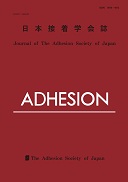All issues

Volume 45, Issue 3
Displaying 1-5 of 5 articles from this issue
- |<
- <
- 1
- >
- >|
Review
-
Hiroshi UYAMA2009 Volume 45 Issue 3 Pages 102-107
Published: March 01, 2009
Released on J-STAGE: January 31, 2016
JOURNAL FREE ACCESSDownload PDF (2040K)
Review
-
Yutaka IWAHORI2009 Volume 45 Issue 3 Pages 108-116
Published: March 01, 2009
Released on J-STAGE: January 31, 2016
JOURNAL FREE ACCESS
Original Paper
-
Keiko OHTSUKA, Akihiro MATSUMOTO, Hajime KIMURA, Kiichi HASEGAWA, Hiro ...2009 Volume 45 Issue 3 Pages 94-101
Published: March 01, 2009
Released on J-STAGE: June 30, 2014
JOURNAL FREE ACCESSDiallyl phthalate resin is used as electrical and electronic parts, and insulation materials forelectronic parts, because of excellent heatresistance, electrical insulation under high temperature and highhumidity, and good dimensional stability.However, the improvement of adhesive property of diallylphthalate resin, to the metal insert department of the electrical and electronic parts and the metalwhich is used for the leadflame of electronic parts is demanded with the miniaturization and theprecision of various electrical and electronic parts in recent years.In this study, allyl ester compounds having sulfur containing group that strengthens interfacial interaction to the metal, were synthesizedto improve the adhesive property of diallyl phthalate resin.They were used as a modifier of diallylphthalate resin and the adhesive property was evaluated.By modification with allyl ester compoundhaving disulfide unit, the T-peel adhesive strength to copper was increased up to about 3.5 times andthe lapshear adhesive strength to copper was increased up to about 2 times compared with diallylphthalate resin.It is suggested that the improvement of interfacial interaction between modified diallylphthalate resin and metal from the observation of copper surface after T-peel adhesive strength testby a scanning electron microscope.View full abstractDownload PDF (2748K)
Original Paper
-
Mariko SASAKI, Hiroaki HONDA, Shinji NAKANO, Syuji FUJII, Yoshinobu NA ...2009 Volume 45 Issue 3 Pages 88-93
Published: March 01, 2009
Released on J-STAGE: June 30, 2014
JOURNAL FREE ACCESSThe surface treatment of spherical silica particles with silane coupling agent having mercapto groupwas carried out. Structure of formed silane-treated layer on silica particulate surface was analyzedusing a pulse NMR. Effects of loading amount and alkoxy group number of silane on the structurewere investigated.For this purpose, silanes with dialkoxy and trialkoxy structures were used.The loading amount of silane on the silica surface was varied from one to eight times of the amount required for monolayer coverage.The relaxation time was longer in the dialkoxy type than in the trialkoxy type of silane.It increased with an increase in the loading amount of silane for the dialkoxytype.However, there was no effect of the loading amount of silane for the trialkoxy type.It was found that the silane structure was flexible for the dialkoxy type, where as it was rigid for the trialkoxy typeView full abstractDownload PDF (2160K)
Original Paper
-
Takanori HAYASHI, Shinya YODOYA, Masakazu FURUTA, Toshio HAYASHI2009 Volume 45 Issue 3 Pages 81-87
Published: March 01, 2009
Released on J-STAGE: June 30, 2014
JOURNAL FREE ACCESSModification of lipoprotein lipase (LPL) with copoly (L-glutamicacid / L-alanine) (EA) was carriedout to stabilize the enzyme and preserve its activity retaining its solubility in water.The modificationbetween LPL and EA was based on covalent bonding.The relative activity (RA) and stability wereevaluated on the modified LPL (EA-LPL) compared to those of free LPL.High RA was found forEA-LPL toward a small ester substrate, p-nitrophenyl laurate(pNPL).Estimation of Michaelisconstants, Km and Vm revealed that the apparent Km, was larger than that of native LPL, while theapparent Vm was smaller than that of free LPL.The thermal and storage stabilities of EA-LPLwerehigher than those of free LPL inspite of their lower RA than that of free LPL.It is concluded thatthe modified LPL (EA-LPL) displayed higher stability than free LPL.View full abstractDownload PDF (2568K)
- |<
- <
- 1
- >
- >|